Sedans are becoming the red-headed stepchildren of the new car market. They’re losing ground to the rising tide of crossovers – which are the same basic thing except they ride higher and have hatchbacks rather than trunks – and so usually have much more room for stuff.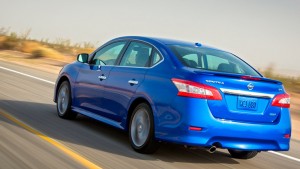
People seem to really like crossovers.
I was thinking these thoughts as I drove around in the ’15 Nissan Sentra – closing in on three years since its last major update back in 2012 (for the ’13 model year).
Between then and now, a great deal has changed.
There are a dozen or more new crossover models on the market that did not even exist back in ’12 – including a whole new class of them (subcompact crossovers like the ’16 Honda HR-V I just reviewed; see here) that are pillaging sales away from sedans, including the Sentra.
It’s easy to understand why this is happening.
The HR-V, for instance, is smaller on the outside – but in every category except headroom, it is roomier on the inside. It has almost four times the cargo space (about 50 cubic feet vs. 15.1 for the Sentra).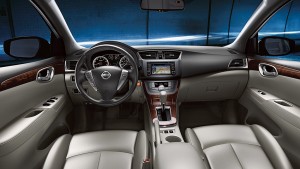
So, why would anyone even consider a sedan like this Sentra?
Well, there’s price.
The raging popularity of crossovers means dealers are charging – and getting – top dollar. The base price of the HR-V, for example, is $19,115 vs. $16,480 for the Sentra. And bet your bippie you’ll pay close to full sticker for the former while there is plenty of room to haggle on the latter.
It – the Sentra – also gets better gas mileage, as much as 40 MPG on the highway vs. a best-case 35 MPG for the HR-V (sedans being generally lighter and having better aerodynamics).
And of course, some people still like sedans.
The extra headroom’s a nice plus, too.
The Sentra is Nissan’s compact sedan, in the same general class as rivals like the Toyota Corolla, Honda Civic, Mazda3 and Ford Focus.
Historically, the Sentra has been one of the sportier models in this class – and so a distinct alternative to economy-minded compact sedans like the Corolla.
But Nissan has decided that a larger – and more fuel-efficient – Sentra will resonate more with buyers. So the current model stretches to within a tick of mid-sized interior space and delivers as much as 40 MPG on the highway, too.
This is about 5 MPG better, incidentally, than a subcompact crossover like the ’16 Honda HR-V gives you.
Prices start at $16,480 for the base S model with 1.8 liter engine and the six-speed manual transmission – about $3k less than an HR-V or similar base-trim subcompact crossover.
A range-topping, loaded SL with continuously variable (CVT) automatic transmission, leather seats and dual-zone automatic climate control starts at $20,670 – about the same as you’d pay for a base trim subcompact crossover like the HR-V.
All trims, including the base S, get Bluetooth wireless connectivity, a USB port for devices and secondary steering wheel-mounted controls for the audio system. SV and higher trims get keyless ignition, an upgraded LCD display and stereo with satellite radio, plus leather trim. SR and SL trims now get four-wheel-disc brakes as part of the standard equipment package.
WHAT’S GOOD
Big enough on the inside to comfortably carry five people.
Outstanding fuel economy with CVT transmission.
Costs thousands less than similar-in-size (on the inside) crossovers like the HR-V and its kin.
WHAT’S NOT SO GOOD
Tortured acceleration with CVT.
Much less room for stuff than in a compact crossover like the HR-V and its kin.
Though only about three years “old,” the current Sentra faces stiff competition from several newer models like the just-updated Honda Civic and the soon-to-be-updated Chevy Cruze.
UNDER THE HOOD
 The Sentra has been upsized – but there’s a downsized engine under the hood: A 1.8 liter, 130 hp four vs. the previous-generation Sentra’s standard 2.0 liter, 140 hp four. The 1.8 liter engine is the same basic engine that’s used in the smaller and (key point) lighter Versa.
The Sentra has been upsized – but there’s a downsized engine under the hood: A 1.8 liter, 130 hp four vs. the previous-generation Sentra’s standard 2.0 liter, 140 hp four. The 1.8 liter engine is the same basic engine that’s used in the smaller and (key point) lighter Versa.
A six-speed manual transmission is standard – but only in base S trim Sentras. All other trims come only with a continuously variable (CVT) automatic.
Either way, acceleration is breathy at best. Because even though the current Sentra weighs slightly less than the previous-generation Sentra (2,822 lbs. vs. 2,906 lbs.) the loss of engine displacement – and 10 hp – is evident when the accelerator pedal is depressed.
Zero to 60 now takes more than 10 seconds under the best circumstances – and that’s a full second behind rivals like the Honda Civic and even the Toyota Corolla (“all new” for the 2014 model year).
The previous Sentra was safely in the nines.
In the car’s defense, several other cars in this segment – among them, the Dodge Dart and also the Mazda3 – aren’t exactly speedy, either. However, these two offer engine upgrades that cut the zero to 60 time down into the mid-low eights. And in the case of the Mazda3 with the Sky-Active engine, they give you that while still delivering exceptionally high gas mileage.
The Sentra comes only with the overtasked 1.8 liter engine.
It’s too little engine for too much car.
Especially when paired with the CVT automatic (more on this below).
For economy-minded buyers, the good news is the Sentra’s 30 city, 39 highway MPG rating (40 MPG, if you order the FE+ enhancements, which include low-rolling resistance tires and underbody aerodynamic deflectors). This is right there with the Honda Civic (30 city, 39 highway in standard trim; 31 city, 41 highway with the optional HF equipment) and better than the Toyota Corolla (27 city, 36 highway) unless you move up two trims to the LE Eco, which manages a class-best 30 city, 42 highway.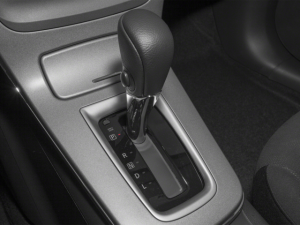
It’s hard to beat any of these fuel-sippers without moving into the hybrid – or diesel – class. And those cost substantially more up front. For instance, the diesel-powered Chevy Cruze has a base price of $25,660 – and while its mileage is very good (27 city, 46 highway) it isn’t spectacularly better than the Sentra’s or the Civic’s or the Corolla’s. The VW Jetta TDI is a much better deal ($21,640 to start) and also gets very good mileage (31 city, 45 highway) but you’re still looking at a $4k-ish price difference up front vs. the Sentra S and that’s going to take several years to work off in down the road fuel-economy savings.
A pending rival that you may want to wait for is the 2016 Chevy Cruze, which will get an eight-speed transmission and a new 1.5 liter turbo engine. It may be the new class-leader, fuel-economy-wise.
The down-powered, de-engined Sentra is noticeably slower than the previous generation Sentra – and the CVT automatic transmission makes it feel (and sound) slower than it actually is.
Even though Nissan has done an admirable job in terms of rendering the bigger (longer, more wheelbase, etc.) 2015 Sentra lighter at the curb than the smaller, previous-generation Sentra, it still weighs a pretty startling (for a compact) 2,822 lbs.
And that’s before the driver gets in.
One 190 pound driver (me) and the car is already over 3,000 lbs. Put two 190 pound passengers in there and the Sentra’s curb weight will be in the neighborhood of 3,200 pounds.
This is not far from the curb weight of my vintage ’70s muscle car – which compensates for its curb weight with a huge (7.4 liter) V8 under the hood.
That’s literally five times the engine, by the way. 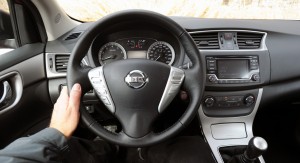
It’s asking a lot of a 1.8 liter, 130 hp engine to get 3,000-plus pounds moving – particularly when you want to move quickly.
Easing around, flat roads, stop-and-go, the Sentra keeps pace as well as other cars in this class. But there is very little in reserve and this becomes painfully clear when you mash the accelerator in the hopes of acceleration. Very little is forthcoming. You can literally hold it to the floor for 30 seconds straight and not quite broach the highest legally allowable highway speeds in the U.S.
The sense of powerlessness is magnified by the CVT, which spins the poor little 1.8 to its 6,000 RPM redline and holds it there as long as you hold the pedal to the metal.
It’s internal combustion Gitmo, a four-stroke waterboarding.
The Sentra’s CVT does have a Sport (as well as an Eco) setting – but I’d rather have a clutch and the ability to launch a little quicker and cull the drivetrain racket once rolling – even if it cost me three or four MPGs. I hugely recommend going with the six-speed manual transmission for this reason. 
I understand why Nissan is hard-selling the CVT. But it wouldn’t be necessary if the Sentra didn’t weigh so much. A 2,500 lb. Sentra could probably hit 42 MPG without the CVT.
Then it would be fuel-efficient – and still fun.
This one’s not.
The new Sentra is an appliance, a Transportation Unit – like the Corolla. That’s apparently the target competition now – not sporty newcomers like the Mazda3 – which appear to be taking over the slot the Sentra used to occupy. And from a business point-of-view, that probably makes sense – because Transportation Units are the volume sellers.
It’s where the money is.
The Sentra edges ever-closer to being a mid-sized car – especially as regards backseat legroom.
Nissan probably decided to build a bigger Sentra for two important reasons. First, to pitch the Sentra as a plausible family car and – second – to put more distance between it and its value-priced sibling, the Versa.
Note that the previous-generation Sentra’s interior specifications were virtually the same as the Versa’s and in one area at least – backseat legroom – the Versa actually had more room than the Sentra. Buyers were probably more willing to overlook the previous Sentra’s slightly cramped interior when the Sentra had more engine and more personality. But now that the Sentra has the same downsized 1.8 liter engine as the Versa? Doesn’t offer better performance than the Versa?
Time to upsize!
Thus, the new car is about two and a half inches longer than the old model and rides on a longer 106.3 inch wheelbase vs. 105.7 inches previously. This makes it look more substantial – and allows for a substantially roomier backseat area: three inches more legroom than before (37.4 inches ) as well as a mid-sized car’s trunk: 15.1 cubic feet vs. 13.1 cubic previously.
Also bigger are the front doors.
Actually, they’re huge relative to the rest of the car – and relative to other cars. I got out my tape measure – 44 inches from edge to edge. For a “compact” car, that’s a big door. Some perspective: I happened to have a Buick Verano sedan the same week I had the Sentra. The Verano – Buick’s entry-luxury sedan – is a bigger car than Sentra – 183.9 inches end to end vs. 182.1 inches for the Nissan. But the Buick’s front doors were three full inches shorter than the Sentra’s.
Of course, a big door can be used to create the illusion of space. One that’s sometimes dispelled when you actually sit inside the car. That’s not the case here, though. The new Sentra’s got slightly more front seat legroom than the bigger-on-the-outside Buick (42.5 inches vs. 42 inches) and more backseat legroom than its big (and mid-sized) brother, the Altima (36.1 inches). But what’s really important is that the ’15 Sentra’s got three inches more backseat legroom than the old Sentra (34.5 inches).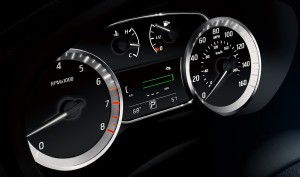
The rest of the Sentra’s interior has also been updated.
The old car’s high-mounted shifter console is gone. In its place, a conventional center console and floor-mounted shifter – available with wood trim covers rather than carbon fiber or brushed metal. Also gone are the previous Sentra’s optional accessory gauges – which had been mounted, 370Z-like, on top of the dash and canted toward the driver.
On the other hand, the LCD screen for the GPS is bigger now.
An amusing touch is the new car’s 160 MPH speedometer – vs. 140 MPH in the old model.
The old car would get into the 100s without too much trouble.
The new one is pretty much done by 90.
THE REST
It’s pretty obvious the trend toward smaller, less powerful – and more economical – engines is upon us. Nissan’s just bowing to the inevitable – and trying to make the best of it.
Still, an optional engine would definitely help the Sentra’s image. Maybe even a diesel (or hybrid) option. The Civic and Cruze offer one – or both (you can also get a natural gas-powered version of the Civic).
Also, three years is a long time these days. Newer models like the Mazda3 and even the new Corolla make the Sentra seem older than it is, just by dint of the picked-up pace of changes in the industry, generally – but especially when it comes to electronic gadgets. When the current Sentra was being designed back around 2011, it was designed with what was then the “latest” stuff in mind. But today you can get stuff that wasn’t even on the horizon back in ’11 – and which other (newer) cars now offer.
In-car WiFi, for instance. Automated parallel parking. Google Earth view GPS mapping.
And how about the ’16 Cruze’s eight-speed transmission?

THE BOTTOM LINE
In most respects, the current Sentra is an objectively better car than the model it replaces. But it’s also blander and much less of a counterpoint to the Corolla than it is an attempt to be a Corolla.
And Toyota still does that better.
The new crop of crossovers, meanwhile, offer the allure of much greater practicality and close-enough fuel-efficiency to be an existential threat to sedans like the Sentra – and the Corolla.
If you value independent media, please support independent media. We depend on you to keep the wheels turning! As you can see from the pie chart (on the main page, top right column) we’re way low at the moment. Please help, if you can.
Our donate button is here.
If you prefer to avoid PayPal, our mailing address is:
EPautos
721 Hummingbird Lane SE
Copper Hill, VA 24079
PS: EPautos stickers are free to those who sign up for a $5 or more monthly recurring donation to support EPautos, or for a one-time donation of $10 or more. (Please be sure to tell us you want a sticker – and also, provide an address, so we know where to mail the thing!)


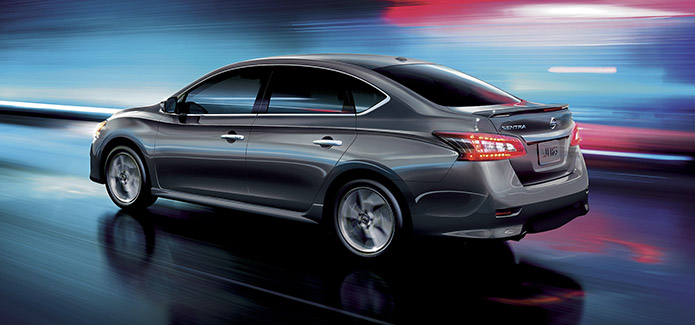


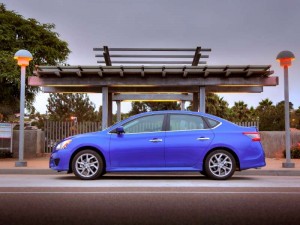

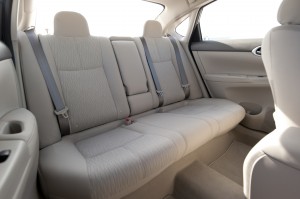






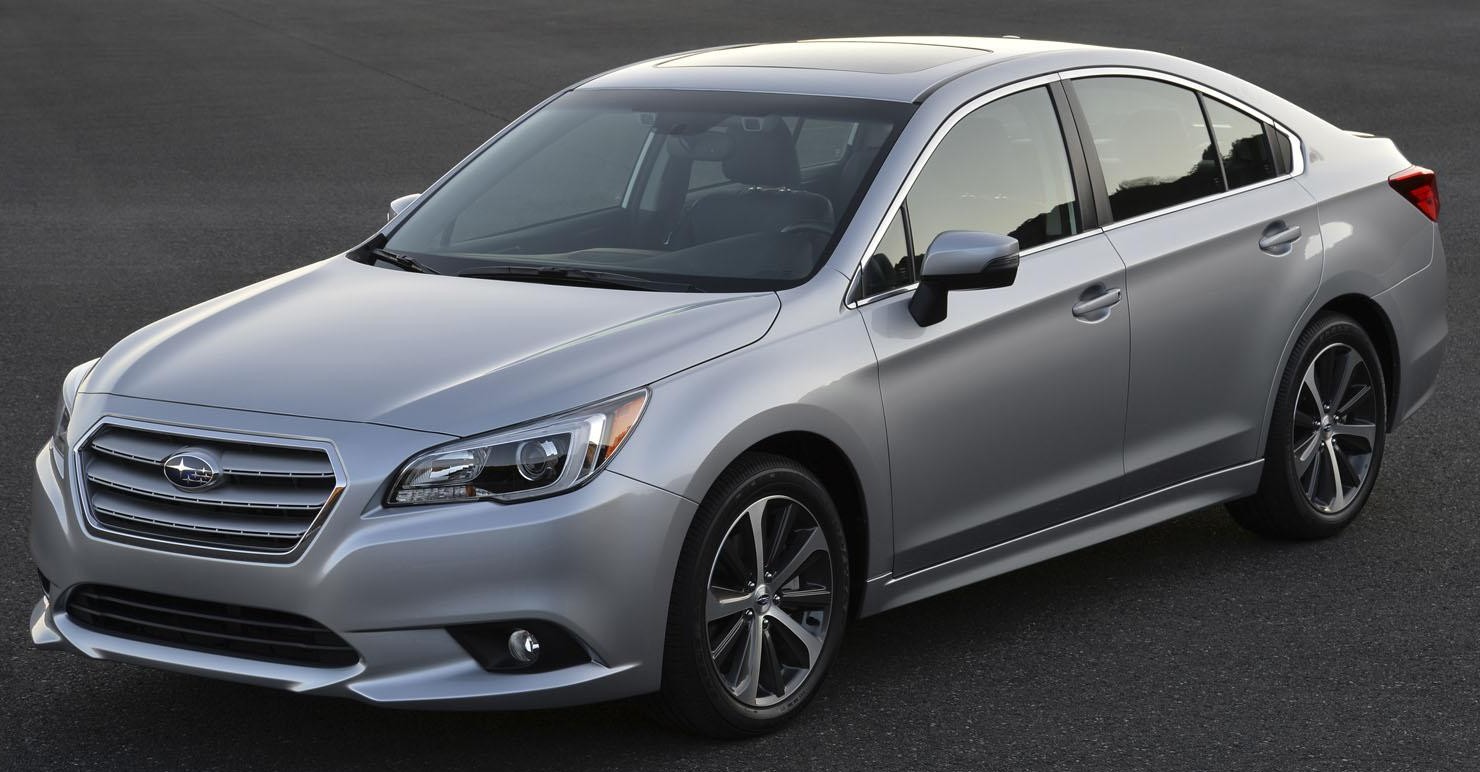
“a huge (7.4 liter) V8 under the hood.
That’s literally five times the engine, by the way.
It’s asking a lot of a 1.8 liter”
Literally four times the engine size: 4 X 1.8 = 7.2, 5 X 1.8 = 9.0